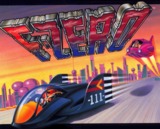F-Zero paved the way for revolutionary graphics and influencing other racers since then.
The game has you controlling one of four futuristic racing vehicles (in later games the number of racers would drastically increase), each of which have their own different settings of speed and control. While on the tracks several other random vehicles will appear to add to the tracks. There are a total of 15 courses spread out through three different different Grand Prix championships. There are three initial difficulties to choose from, but completing the hardest one will unlock an even harder difficulty. These added difficulties and the variety of tracks add to the replayability. The game also includes its standard practice mode as well. However, what's weird is that this game didn't include a multiplayer option. That's a shame since the game could have greatly benefited from that. The controls in this game are very smooth and precise for the most part, that is until you collide with characters or a hazard in which things can get a bit hectic.
This game is shown to be a very fast paced racer for the SNES and that's what helped to define the series. Each of the 15 courses have various traps and environmental hazards, ranging from electrical barriers surrounding the tracks, gravel to slow you down, ice to make things slippery, land mines, and more. You have a power meter that works as your health bar. You only have a select few chances before it's game over. To help you heal are tracks of energy that replenish your power. Certain levels also have boost pads to help you go faster. After the first lap you are given the opportunity to boost. But be cautious about it since it depletes your power.
In terms of their design some of the tracks, unfortunately, do appear rather simple. But thankfully a majority of the tracks are rather well designed and are challenging in their own right. Speaking of which this game helped to start of the series' known difficulty. Not only are some of the tracks rather challenging thanks to sharp turns and stage hazards, but the AI doesn't hold back either. Colliding with them can be the quickest way to lose control. Even the slightest misstep in your driving can give them ample opportunity to instantly catch up. So you have to do a little practicing to master tracks and combat the AI.
As mentioned earlier this game was a prime example of what Mode 7 could do. This is simply one of the best looking games on the SNES. The Mode 7 technology is really impressive and still holds up rather well today. The game is very fast, smooth, bright, and colorful. The music and sound is also top notch. A good deal of the music tracks are rather memorable and some of them have been used in later games in the series.
To sum things up:
PROS:
-Superb graphics
-Great music and sound
-Good controls
-Challenging, fast-paced gameplay
-Most of the courses are rather well designed
-Added difficulties and tracks add replay value
CONS:
-Some tracks are more simplified
-No multiplayer
F-Zero proved to be great launch title for the system and helped to create the other games in the series and even inspired other games like Super Mario kart and Wipeout. Fans of the series should definitely have this in their collection.

